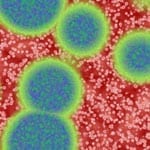 Dutch virologist Ron Fouchier has been at the center of the debate on Dual Use Research of Concern (DURC) since last year when his team at Erasmus Medical Center in the Netherlands was able to genetically alter the bird flu virus H5N1 so that the viruses were able to spread from ferret to ferret through coughs and sneezes. After months of controversy, his research was published this week in the journal Science. (See Airborne Transmission of Influenza A/H5N1 Virus Between Ferrets).
Dutch virologist Ron Fouchier has been at the center of the debate on Dual Use Research of Concern (DURC) since last year when his team at Erasmus Medical Center in the Netherlands was able to genetically alter the bird flu virus H5N1 so that the viruses were able to spread from ferret to ferret through coughs and sneezes. After months of controversy, his research was published this week in the journal Science. (See Airborne Transmission of Influenza A/H5N1 Virus Between Ferrets).
The research was funded by the U.S. government, and in November 2011 federal officials asked to review the manuscript on his work and weigh in on whether publishing it could be dangerous. The study had already been submitted to the journal Science.
Enter the public and political debate on the ‘censorship’ of science and the lack of well-understood controls within the U.S. government to oversee research that may have DURC implications. Congress questioned why the controversial manuscript was on the verge of publication in a major science journal before it was brought under review. Agencies were brought before committees to testify on their existing and future DURC policies.
Initially, the National Science Advisory Board for Biosecurity (NSABB) called for a moratorium on publication of the Fouchier manuscript, and a second paper on H5N1 by Yoshihiro Kawaoka of the University of Wisconsin-Madison. A new Federal Policy for Oversight of Life Sciences Dual Use Research of Concern was released at the end of March. Days later, the NSABB reversed its decision and voted to allow publication of both manuscripts with slight modifications.
The NSABB vote for publication was unanimous for the Kawaoka paper, but split for the Fouchier data. Internal NSABB letters leaked to the press did little to affirm confidence in the process and raised further questions on the hastiness of the new federal policy and what the real implementation plans will look like. (See CIDRAP Director Letter to NSABB Leaked).
“I’ve been asked whether this felt like a real victory. And it still doesn’t,” says Fouchier. “Because I am still afraid that some governments might be installing more of a regulatory system than I think is needed. And if that comes from this work, then I am not particularly happy. But, of course, we are very happy about the publication itself.”
As government officials grapple with how to manage future experiments that might raise similar concerns, the goal is to prevent a repeat of this controversy, while also making sure not to create irrational obstacles to beneficial research.
“We are not playing with viruses just for the heck of it,” says Fouchier. “We are doing fundamental research, to prevent public health threats.”
The publication of the Fouchier research certainly does not mean the debate is over. Top flu researchers around the world are still under a voluntary moratorium on some of their studies. The new U.S. federal policy on DURC only applies controls to federally-funded projects. And perhaps the biggest puzzle of all is how to cooperate on DURC matters internationally, given the global biosecurity implications of potentially pandemic pathogens.

